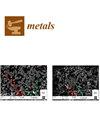以量子力学离子-水二聚体相互作用为目标的二价金属阳离子点电荷模型设计
IF 2.5
3区 材料科学
Q3 MATERIALS SCIENCE, MULTIDISCIPLINARY
引用次数: 0
摘要
二价金属阳离子在生物化学和材料科学中至关重要,它们在水溶液中的结构和热力学性质经常被用作开发离子模型的目标。本研究针对基于量子力学(QM)的离子-水二聚体相互作用,提出了一种设计二价金属阳离子(Mg2+ 和 Ca2+)和 Cl- 非键点电荷模型的策略。所设计的模型准确地再现了气相中离子与水的相互作用,并对水溶液中的非目标特性,如离子与水的氧距离(IOD)、配位数(CN)以及 MgCl2 和 CaCl2 溶液在低浓度时的密度和粘度表现出合理的性能。我们的金属阳离子模型大大高估了离子的水合自由能(HFE),而 Cl- 模型则表现良好。这些结果加上盐溶液的密度和粘度被高估,表明有必要在设计离子模型时重新优化离子间的相互作用和/或包括极化效应。设计的 Mg2+ 模型能够在对金属蛋白进行 MD 模拟时维持晶体金属结合网络,这表明该模型在生物分子模拟中具有巨大潜力。这项工作凸显了基于QM的离子模型在推动生物和材料系统中金属离子相互作用研究方面的潜力。本文章由计算机程序翻译,如有差异,请以英文原文为准。
Design of Point Charge Models for Divalent Metal Cations Targeting Quantum Mechanical Ion–Water Dimer Interactions
Divalent metal cations are of vital importance in biochemistry and materials science, and their structural and thermodynamic properties in aqueous solution have often been used as targets for the development of ion models. This study presented a strategy for designing nonbonded point charge models of divalent metal cations (Mg2+ and Ca2+) and Cl− by targeting quantum mechanics (QM)-based ion–water dimer interactions. The designed models offered an accurate representation of ion–water interactions in the gas phase and showed reasonable performance for non-targeted properties in aqueous solutions, such as the ion–water oxygen distance (IOD), coordination number (CN), and density and viscosity of MgCl2 and CaCl2 solutions at low concentrations. Our metal cation models yielded considerable overestimates of the hydration free energies (HFEs) of the ions, whereas the Cl− model displayed good performance. Together with the overestimated density and viscosity of the salt solutions, these results indicated the necessity of re-optimizing ion–ion interactions and/or including polarization effects in the design of ion models. The designed Mg2+ model was capable of maintaining the crystal metal-binding networks during MD simulation of a metalloprotein, indicating great potential for biomolecular simulations. This work highlighted the potential of QM-based ion models to advance the study of metal ion interactions in biological and material systems.
求助全文
通过发布文献求助,成功后即可免费获取论文全文。
去求助
来源期刊

Metals
MATERIALS SCIENCE, MULTIDISCIPLINARY-METALLURGY & METALLURGICAL ENGINEERING
CiteScore
4.90
自引率
13.80%
发文量
1832
审稿时长
1.5 months
期刊介绍:
Metals (ISSN 2075-4701) is an open access journal of related scientific research and technology development. It publishes reviews, regular research papers (articles) and short communications. Our aim is to encourage scientists to publish their experimental and theoretical results in as much detail as possible. Therefore, there is no restriction on the length of the papers. The full experimental details must be provided so that the results can be reproduced. Metals provides a forum for publishing papers which advance the in-depth understanding of the relationship between the structure, the properties or the functions of all kinds of metals.
 求助内容:
求助内容: 应助结果提醒方式:
应助结果提醒方式:


